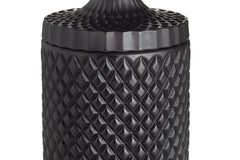Are Candles Bad for the Environment? Their Eco Impact
Candles have long been cherished for their ability to cast a warm glow, create ambiance, and infuse spaces with delightful scents. Yet, as we immerse ourselves in the comforting embrace of candlelight, it's essential to recognize the intricate interplay between these flickering flames and the environment. From the selection of materials to the manner of burning, every aspect of candle usage can leave a lasting imprint on our planet.
In this blog, we’ll explore the ecological implications of candlemaking, the regulatory frameworks guiding the industry, and pathways toward sustainable candle usage.
Candlemaking Materials
Candles can be made from a variety of materials, each with its own environmental impact. Some of the most common materials used in candle-making include paraffin wax, beeswax, soy wax, and palm wax.
- Paraffin wax is a petroleum byproduct and is often the cheapest option, but when burned, it can produce harmful chemicals.
- Beeswax, while more expensive, is a natural and renewable resource that does not produce harmful chemicals.
- Soy wax is another eco-friendly option made from soybeans, but it can also have negative environmental impacts if the soybeans are grown using pesticides or if they come from genetically modified plants.
- Palm wax, made from palm oil, can contribute to deforestation and harm wildlife if it is not sustainably sourced.
It’s important to consider the source and sustainability of the materials used in candles to minimize the environmental impact. At La Lueur, we use a blend of eco-friendly waxes like coconut wax and apricot wax, which are renewable sources derived from coconut pulp and apricot kernels. Coconut wax is a high yield renewable crop that makes it a great sustainable option. Even the process of making coconut wax is highly eco-friendly, made without harsh chemicals or pollutants, and does little harm to the environment when disposed of. Apricot wax also does not harm the environment and helps with the scent throw of our candles.
Candles and Air Quality
While burning candles may create a cozy atmosphere in your home, it's essential to recognize their potential impact on indoor air quality. Candles crafted from paraffin wax are particularly noteworthy for emitting chemicals like benzene and toluene. These compounds, classified as volatile organic compounds (VOCs), can linger in the air long after the candle has been extinguished. Prolonged exposure to VOCs has been linked to respiratory issues, exacerbation of allergies, and aggravation of asthma symptoms, highlighting the importance of mindful candle selection.
Proper ventilation is crucial in mitigating the impact of candle emissions on indoor air quality. Opening windows and doors allows fresh air to circulate, diluting the concentration of pollutants and reducing potential health risks. Additionally, limiting the number of candles burned simultaneously can help minimize the overall emission load, preserving air quality within the home environment.
Understanding the relationship between candles and air quality empowers consumers to make informed and environmentally conscious decisions when selecting candles for their living spaces. By opting for candles crafted from natural, non-toxic materials and practicing responsible burning habits, individuals can create a cozy ambiance without compromising air quality or health.
The impact of candles on water quality
Beyond their effect on air quality, the repercussions of burning candles extend to our waterways, posing a significant threat to aquatic ecosystems. When paraffin wax candles are ignited, the same VOCs and particulate matter that affect our air eventually settle onto surfaces, where they await transportation by rainfall or runoff into nearby water bodies.
Once introduced into aquatic environments, the chemical constituents of candle emissions can wreak havoc on delicate ecosystems. Fish and other aquatic organisms are particularly vulnerable to these pollutants, as they can disrupt reproductive cycles, alter behavior, and impede growth patterns. Furthermore, the accumulation of candle-derived particles and chemicals in water can lead to the obstruction of marine animals' gills, compromising their respiratory functions and survival.
The consequences of candle pollution on water quality extend far beyond immediate harm to aquatic life. Contaminants introduced into water bodies can bioaccumulate within the food chain, posing risks to human health as well. By selecting candles crafted from natural, biodegradable materials such as coconut and vegetable waxes, consumers can help mitigate these adverse effects on water quality. Embracing sustainable alternatives not only safeguards the health of aquatic ecosystems but also fosters a deeper connection to our shared responsibility as stewards of the environment.
Regulations and Standards in the Candle Industry
The candle industry, like many others, is subject to various regulations and standards aimed at ensuring product safety, quality, and environmental responsibility. These regulations encompass aspects such as ingredient transparency, emissions, labeling requirements, and packaging sustainability. Here's an overview of some of the key regulations and standards governing the candle industry:
Consumer Product Safety Commission (CPSC): In the United States, the CPSC sets regulations aimed at protecting consumers from hazardous products. While there are no specific regulations solely dedicated to candles, the CPSC oversees general product safety standards that apply to candles, ensuring they meet requirements for safe use.
ASTM International Standards: ASTM International develops and publishes voluntary consensus standards for various industries, including candles. ASTM standards address aspects such as candle materials, performance testing, labeling, and safety requirements. Compliance with ASTM standards demonstrates a commitment to product quality and safety.
Emissions Standards: Several countries have established emissions standards for candles to limit the release of harmful substances during burning. For example, the State of California has implemented regulations under Proposition 65 that require warnings on products containing chemicals known to cause cancer, birth defects, or other reproductive harm, including certain candles.
Fragrance Ingredient Disclosure: Increasingly, consumers are seeking transparency regarding fragrance ingredients in candles. While regulations may not mandate fragrance ingredient disclosure, some companies voluntarily disclose fragrance components to address consumer concerns about potential allergens or harmful chemicals.
Industry Standards and Certifications: Various industry associations and organizations establish standards and certifications to promote best practices and sustainability in the candle industry. For example, the National Candle Association (NCA) in the United States provides guidance on candle manufacturing practices, safety protocols, and environmental stewardship.
Compliance with these regulations and standards is essential for ensuring the safety, quality, and environmental responsibility of candles. Manufacturers and retailers must stay informed about evolving regulations and industry best practices to meet consumer expectations and maintain regulatory compliance. By adhering to these standards, the candle industry can contribute to a safer, more sustainable marketplace for consumers worldwide.
Ways to Reduce Your Carbon Footprint When Using Candles
When it comes to reducing your carbon footprint, even small changes can make a big difference. Here are some ways to enjoy candles while still being kind to the environment:
- Choose Natural Materials: Look for candles made from beeswax, soy wax, coconut wax, apricot wax or vegetable-based waxes. These materials are biodegradable and do not contain harmful chemicals. Choosing the right blend of waxes that did not cause damage to the environment and allowed for a superior burning experience was our highest priority when creating La Lueur candles.
- Avoid Paraffin Candles: Paraffin wax is derived from petroleum, a non-renewable resource that produces harmful emissions when burned. Avoiding paraffin candles can significantly reduce your carbon footprint.
- Opt for Non-Toxic Fragrance: Many candles contain fragrances that can be concocted from any of the fragrance industry’s 3,000+ chemical ingredients and are never disclosed to the consumer. Many of these release harmful chemicals when burned, but the average consumer wouldn’t know how to decipher the convoluted research behind each to be able to make an informed decision. The solution? Look for candles scented with essential oils or clean fragrances that are mindfully sourced like ours.
- Use Reusable or Recyclable Candle Holders: Instead of buying disposable candle holders, choose options that can be reused or recycled. Be sure to check out our post on ways to recycle your La Lueur candle vessel here!
- Trim the Wick: Trimming the wick of your candle to ¼ inches can help reduce soot and smoke and extend the life of your candle.
Candles may seem like a small indulgence that stays confined within the walls of our homes, but their impact on the environment and the entire ecosystem is undeniable. From the materials used to make them to the pollution they create when burned, candles contribute in significant ways to our carbon footprint. By selecting candles made from sustainable materials, burning them sparingly and properly disposing of them, you CAN make a difference.
La Lueur candles are made of natural Coconut Wax Blend, 100% cotton wicks, and premium fragrance oils free of Parabens, Phthalates, and Sulfates. Every candle is still hand-poured and crafted to perfection in artisanal, luxe vessels that can turn any room from drab to chic.



Leave a comment